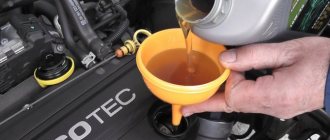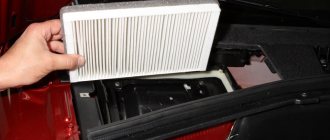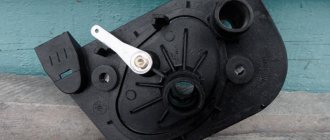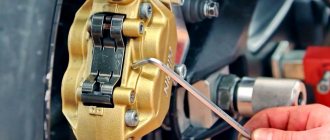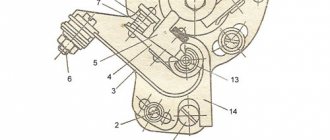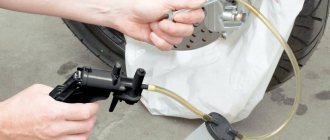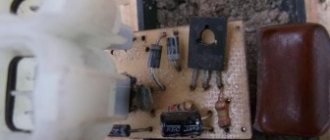Power steering diagram
Bleeding the power steering and its system is carried out when replacing the working fluid, airing, which may be the result of a malfunction or repair work. Air trapped inside not only reduces the efficiency of the power steering, but can also cause serious damage, in particular, failure of the power steering pump. Therefore, pumping the hydraulic booster must be carried out in strict accordance with existing technology.
Why do you need power steering?
Power steering is a system that is part of the steering system and is aimed at reducing the effort exerted by the driver on the steering wheel when changing direction.
At the same time, this system ensures that the driving conditions of the steered wheels are transmitted to the steering wheel, the so-called “road feeling”; this system also takes on shock loads from the wheels and absorbs them without transferring them to the steering wheel.
Operating principle of hydraulic power steering
The hydraulic booster serves to assist the driver when turning the steering wheel. Consists of the following main elements:
- pump;
- expansion tank;
- highways;
- spool valve;
- two cylindrical cavities inside the rail.
To better understand why changing the oil in the power steering is a mandatory procedure, let’s briefly consider its operating principle.
Power steering operating principle
The pump takes liquid from the tank and pumps pressure into the line. When the steering wheel is turned, depending on which direction the force is applied, the spool valve directs a flow of liquid under pressure into one of the cylinders.
Due to the pressure on the piston inside the rack, additional force is created, which helps the rod move in the desired direction and reduces the necessary force that must be applied to the steering wheel.
Oil here plays not only a lubricating and protective function, but is also a carrier of energy. Therefore, the efficiency and durability of the entire system depends on its condition.
What is power steering
Power steering or power steering is a rather complex unit that allows the driver to easily control the vehicle. The main structure consists of the following elements:
- pump;
- hoses;
- steering rack;
- working fluid;
- hydraulic cylinder;
- expansion tank.
The working fluid circulates inside the power steering system, ensuring its normal operation. If we take the traditional recommendations of car manufacturers, then it should not be changed throughout its entire service life. But the formation of an airlock changes everything.
How power steering works is shown in the video:
Advice! There are a number of criteria by which you can determine whether it is worth changing the working fluid. For example, if it is darkened and heavily soiled, then replacement is necessary.
In some designs, the steering rack and cylinder are one piece. But even in this case, pumping the power steering allows you to get rid of the airlock quickly and without problems.
The power steering pump is enclosed in a metal housing. The drum rotates inside. Its blades help fluid circulate freely within the system. At the same time, it enters the steering fluid under the pressure specified by this unit.
In power steering, the pump operates thanks to a belt drive. If, as an alternative, we consider an electric amplifier, then everything happens thanks to the electric motor. Each technology has its own advantages and disadvantages.
The shape of the power steering steering rack resembles a cylinder. Inside there is a gear structure. It plays the role of a rod, a control mechanism and a piston. At the ends of the structure there are steering rods. They connect to the hub.
Attention! The steering rod has a movable connection with the gear rack.
Knowledge of the power steering design will allow you to do the pumping correctly. After all, such a procedure cannot be carried out without understanding the internal structure of the part. The fact is that even a small mistake can lead to a complete replacement of the unit.
The spool mechanism plays an important role in the power steering design. In fact, this is a pressure distributor. The degree of distribution directly depends on the rotation of the steering wheel.
Depending on the need, the working fluid goes through channels to the power steering piston or simply circulates around the ring. Somewhere along this segment a plug forms, and in order to get rid of it you need to pump it.
The expansion tank is located slightly higher than the pump. The material used is ordinary plastic. Inside there is a filter and a divider, the latter allows you to cut the flow of liquid.
To perform a high-quality power steering pump, you need to know what kind of fluid circulates inside the system. Typically, manufacturers use a mixture of oils to ensure the best performance of the unit.
The color of the power steering mixture must match the color on the expansion tank plug. Its specifications must also be indicated on the body. It is noteworthy that the color of the substance may differ significantly between cars of different brands.
Some manufacturers achieve extremely interesting colors. As an example, we can recall that its specialists pump green liquid into the hydraulic booster.
Attention! When pumping or replacing the power steering, you can fill only the mixture that meets the specifications. Otherwise, it may cause serious damage to the mechanism.
Power steering device
Power steering is a closed, interconnected hydraulic system of components consisting of:
- Pump.
- Distribution device.
- Hydraulic cylinder.
- Backa.
- High and low pressure hoses.
Pump
The main part of the power steering design is the pump. With its help, pressure is created in the power steering and oil circulates in the system. It is fixed near the engine and driven by the crankshaft using a belt or gear drive (drive). The most common type of pump is a vane pump, usually a vane pump; it provides high wear resistance and high efficiency. However, it has a weak link, namely the bearing, which is why it has to be repaired. The pressure in this type of pump is about 150 bar, which is very high.
Distributor
The distributor in the power steering is a kind of regulator that directs oil from the reservoir to the hydraulic cylinder and back. It can be installed both on the steering gear shaft and on some parts of the steering mechanism. There are two types of distributor:
- axial - if the spool makes translational movements;
- rotary - if it makes rotational movements.
Hydraulic cylinder
Or as the power cylinder is also called, it performs the function of turning the wheels. The fluid in the power steering presses against the piston under pressure and forces the rod to extend, causing the wheels to turn. In order to push the rod back, the fluid from the reverse side presses on the piston and the wheels return to their original position. The hydraulic cylinder can be located both on the steering mechanism and between the steering gear and the vehicle body.
Tank
A reservoir for working fluid, which ensures the operation and lubrication of all connecting parts of the power steering. It contains a special filter to prevent dirt from entering, since the distributor is very sensitive to this. To check the oil level there is a special dipstick and marks on it. The tank is located under the hood, usually in a visible place next to the antifreeze tank and has a cylindrical shape.
High and low pressure hoses
Of course, all fluid circulation through the power steering system is provided by hoses, which are divided into:
- high pressure hose;
- low pressure hose.
High pressure power steering hoses circulate oil between the pump, rotary or axial distributor and hydraulic cylinder. And low pressure returns this oil from the distributor to the tank, as well as from the tank to the pump. It is important to monitor the condition of the hoses to avoid fluid leaks and damage to the entire mechanism.
How to bleed power steering on a Gazelle
Bleeding the power steering system on a Gazelle car is required in the following cases:
- when air enters the system;
- after performing repairs, which were accompanied by depressurization of the system.
Procedure for removing air from the system:
- Fill the power steering system with hydraulic fluid.
- Lock the handbrake in the upper position and place brake pads under the rear wheels of the car. Raise the front of the machine.
- Set the steering wheel to a straight position. Start the engine.
- Turn the steering wheel to the right until it stops. At this time, air bubbles will appear in the fluid reservoir.
- Turn the steering wheel all the way to the left to release any remaining air from the hydraulic system.
- Repeat the procedure until air bubbles stop appearing in the tank. If necessary, add fluid to the maximum mark.
With these simple procedures you will extend the life of the power steering system on your car and will enjoy comfortable driving for a long time.
The power steering on a Kamaz truck allows the driver to spend a minimum of effort on steering his vehicle, and also softens the shock when driving on a not too smooth road and provides control of movement if sudden damage to the tires occurs.
Malfunctions of the Kamaz hydraulic booster that require power steering repair most often manifest themselves as follows:
- The steering wheel turns hard when the car turns left or right;
- There is a delay in the steering wheel during the reverse motion;
- The car moves unstably in a straight line (you have to constantly level the car);
- You can hear a loud noise from a running pump;
- Hydraulic oil is leaking .
Before starting to repair the Kamaz power steering, our service center specialists carry out a complete diagnosis of the device. In this case, it is necessary to check the pressure in the steering system at maximum turns of the steering wheel, evaluate the flow of fluid, and also measure the pressure that the pump receives. To carry out power steering repairs, the latter is removed from the truck and undergoes complete or partial disassembly. All parts of the mechanism that have failed or are excessively worn are replaced with new ones.
The Kamaz hydraulic booster was initially designed in such a way as to withstand heavy loads, so power steering repair will not be required for a long time if it is checked and adjusted in a timely manner. These services are also provided by our technical center. The use of the latest diagnostic methods allows us to promptly identify and eliminate any faults in the hydraulic booster. All Kamaz power steering repair work is carried out by experienced mechanics using modern equipment with full quality control.
Where is the power steering reservoir located?
The power steering pump reservoir (also called the power steering reservoir) is an important part of the power steering system, which is a steering system that assists steering by applying hydraulic pressure to the steering mechanism. Most cars today have hydraulic power steering.
The power steering pump reservoir contains the hydraulic fluid that the power steering pump moves to help you steer. Without this fluid, the system will not function. Often the reservoir is directly connected to the power steering pump, which is located on the front of the engine near other engine accessories; however, the exact location of the pump will vary from one engine to another. Sometimes the power steering pump reservoir is installed remotely. In either case, there will be a pair of fluid lines to move fluid into and out of the pump. An example of the location of the tank is shown in the photo below:
Stay safe on the road
Air getting into the power steering system is not uncommon. But you want to clean up and, if necessary, fix any issues that led to the problem as soon as possible.
Trapped air in the steering system can cause:
- system noise
- uncertain steering
- damage to system components
Therefore, bleeding the system will not only remove trapped air from the lines, transmission and pump, but will also prevent costly repairs and a possible accident due to poor vehicle control.
Check, diagnose and, if necessary, correct steering system faults as soon as they appear.
What types of power steering fluids are there?
Based on the foregoing, it can be understood that all elements of the system only provide fluid pressure, give the desired direction to the parts and convert pressure into force. The main working element in the power steering system is liquid.
Power steering fluid, no matter who makes it, is based on petroleum components. Essentially this is the same oil, only with certain properties.
If motor oils have the main task of lubricating rubbing parts, then power steering oil has the task of transmitting force.
And since it must be quickly transmitted through the channels, the power steering fluid should not be very viscous, but at the same time this oil should also lubricate the system elements, but to a slightly lesser extent than engine oil.
Power steering fluids are available in two types:
- Mineral;
- Synthetic.
Mineral is used in most power steering, synthetic is less common.
A feature of these liquids is not interchangeability, as is the case with motor oils. In this case, switching from mineral fluid to synthetic fluid will lead to power steering failure.
And all because synthetic fluids contain additives that negatively affect the service life of rubber-based rubber elements, but there are enough such elements in power steering.
Ford synthetic power steering fluid “DP-PS”, 1 l.
Usually in those The vehicle documentation indicates that synthetic power steering fluid is used, and only that should be used.
If there is no information on the fluid in the documentation, then the car uses mineral by default.
Power steering oil requirements
- Heat resistance.
Since the oil is intended not only for lubricating mechanisms, it acts as a heat sink from heated parts and parts of the hydraulic booster. The liquid must be resistant to high temperatures up to 110⁰C, and also not lose its properties at low pressure and at temperatures down to minus 35⁰C.
- Stable viscosity.
Power steering oil contains additives that control the level of fluid viscosity under conditions of changing ambient temperatures. Thanks to this, at low temperatures the oil retains its properties and does not thicken, which allows you to rotate the steering wheel without extra effort.
- Transparency and homogeneity.
A distinctive property of good and high-quality oil is its transparent appearance and uniform consistency. Even after the machine has been idle for a long time, additives should not precipitate and clog the oil.
- Wear resistance.
Oil still has an aggressive effect on the rubber parts and mechanisms of the machine. It is worth choosing a type of fluid that has special additives with the function of a protective film, thereby reducing the wear life of rubber parts.
- Slight foaming.
An undesirable phenomenon in the power steering oil tank is foaming. The appearance of bubbles can have a bad effect on the steering wheel turning mechanism, namely, the process of transferring force from the steering wheel to the turning mechanism will be difficult. So you should pay attention to this important criterion when choosing oil.
Color characteristics of liquids
Also, power steering fluids are divided among themselves by color. Interestingly, initially they were all red - Dexron.
According to their class, power steering fluids are classified as automatic transmission fluids (ASF), but power steering fluids have a different designation PSF
.
At the same time, PSF is the same as ASF, but only the latter’s additives are slightly different, and are designed to work with gearbox clutches, which power steering does not have.
But these additives do not in any way affect the operation of the power steering, so Japanese cars often come from the factory with ASF poured into the power steering reservoir.
Characteristics of power steering
First, let's look at the main characteristics of the KAMAZ 6520 or any other model. Let's start with the purpose and device.
Purpose
The main purpose of the power steering system is to minimize the effort used to turn the steering wheel when steering, as well as performing many maneuvers when driving at low speeds. In addition, thanks to the power steering system, the impact on the steering wheel will be more noticeable if the car is moving at high speed. If the power steering fails for some reason, this will result in the driver having to exert significantly more effort to turn the steering wheel.
Device
Now let's briefly look at the power steering device.
This system consists of the following elements:
- Switchgear. This component is used to direct the flow of working fluids, in particular hydraulic oil, into the lines and cavities of the system.
- Hydraulic cylinder. This device performs the function of converting hydraulic pressure into mechanical work of pistons and rods.
- The working material in this case is hydraulic fluid. With its help, force is transferred from the pump to the hydraulic cylinder. In addition, thanks to the liquid, all rubbing components and components of the system are lubricated.
- KAMAZ power steering pump. Thanks to this device, the pressure required for normal operation is constantly maintained in the system. This element is also used to circulate the working fluid.
- Connecting elements or lines. They are used to bring together all the working components of the system.
- Control device or electronic unit. With its help, direction and adjustment of the operation of the amplifier are carried out.
Features of the pump
The pumping device is installed in the collapse of the BC. Domestic trucks use a gear top drive, but the device itself is of the blade type. In accordance with the technical documentation, this unit is characterized by double action, that is, with one turn of the steering wheel it carries out two cycles of suction and discharge.
Let's take a brief look at the operating principle. When the wheel turns, the rotor blades begin to rotate, which, in turn, are pressed against the stator device. Working fluid begins to flow into those blades that, when pressed, coincide with the holes on the body. Further, thanks to the same blades, the consumable material enters the narrower holes that exist between the stator and the rotor.
At the moment when the working surfaces can coincide with the holes on the distribution disk, the consumable material will come out beyond it. Next, the oil will pass through the lower valve; for this, high pressure is formed in the system.
The working fluid, leaving the cavity behind the distribution disk, will flow onto the rotor blades, as a result of which they will be pressed even more tightly against the stator plane. The process of pumping the substance, as well as its absorption, is carried out simultaneously in two places. As the number of revolutions of the rotor device increases, liquid from the surface behind the disk will not pass through the calibration hole. By creating pressure in the system, the bypass valve is opened, and part of the consumable material, through the manifold, is again supplied to the suction surface (the author of the video about replacing the hydraulic booster on a KAMAZ is Mathur Malay).
Why bleed your power steering system?
Perhaps the steering wheel has become noisy, or the steering wheel has become difficult to turn. These are potential signs of air getting into the power steering system.
Signs of trapped air in the steering system:
- You hear a whistling sound from the steering pump.
- Bubbles appear in the formation fluid.
- The reservoir fluid is low and foamy.
- The steering wheel is difficult to turn.
- The steering system is leaking.
- You hear a wheezing or growling sound at low speeds when turning.
- The steering wheel groans when it turns left or right.
- You hear a whirring noise when you turn the steering wheel.
- The steering system makes noise when operating.
Air can enter the system in different ways:
- due to damaged hose, fitting, seal or component
- after you have replaced some system component
- after you have disconnected and reconnected the hose
The following sections will help you check for trapped air and, if necessary, bleed the power steering system. You will find more than one method that you can apply, depending on your specific model.
Only add power steering fluid recommended by your vehicle manufacturer for your specific application.
- Checking the steering system for trapped air
You may not be sure if there is air in your steering system. Here are a couple of simple tests you can do at home to check your system for air.
Why is pumping needed?
As noted above, the power steering system is airtight . It must be free from moisture, air, dust or dirt, because only in this case can it fully perform its functions - apply the required pressure to the piston, lubricate the system’s spare parts and remove heat. Not only external factors have a detrimental effect on the operation of the hydraulic booster system.
The first hydraulic power steering was manufactured in 1925. Its creators were Francis Davis and George Jessop. The scientists installed the power steering on a Pierce-Arrow Roadster, owned by Davis.
Careless operation of the machine can cause a number of problems, resulting in:
- parts of parts wear out, which causes particles of steel chips to enter the liquid;
- rubber elements collapse and become unusable, as a result of which the seal is broken;
- the composition of the oil mixture changes under the influence of high temperatures;
- Hoses and pipes are destroyed.
All the factors described above lead to the fact that after a certain time the power steering system depressurizes.
This situation is very dangerous for vehicles, because:
- is capable of completely changing the operating technical properties of the drive;
- leads to the steering wheel being blocked in the right or left position, due to which it is not possible to control the vehicle;
- provokes uneven rotation of the steering wheel, which significantly complicates the precise execution of the maneuver.
Important! Pumping the power steering is a very serious and responsible undertaking, which guarantees the stable functioning of the steering. It is for this reason that it is extremely important to entrust the procedure to professional craftsmen.
To rid the system of air, they practice bleeding it, which allows you to restore the full functioning of the steering. At the same time, it is important not only to properly pump the power steering, but to maintain its performance for a long time.
To do this, experts advise:
- use only high-quality oils recommended by the manufacturer;
- remove air from the system, strictly following the instructions;
- replace the working mixture in full;
- monitor the condition of the steering rack boot and systematically clean the parts from dust.
Using a power steering bleed kit
This is the recommended method for bleeding the power steering system in a late model vehicle, but you can use it on other vehicle models as well.
Using a vacuum pump draws any air pockets in the system to the surface of the fluid in the reservoir and prevents any damage to the seals that might be caused by turning the steering wheel out of the lock and into the lock position several times using the normal purging method.
In addition, using a steering system bleeding kit can significantly speed up the procedure.
To do this you will need a hand vacuum pump and a bleed kit. Some auto parts stores may provide you with a hand vacuum pump and possibly a bleeder kit.
- Park your vehicle in a safe place on level ground. Make sure the engine is cool.
- Open the hood.
- Wipe the steering system reservoir cap.
- Remove the cover.
- Install the drain kit adapter into the reservoir in place of the cap.
- Connect the hand vacuum pump to the air vent adapter.
- Set the parking brake and transmission to park (automatic) or neutral (manual).
- Start the engine.
- Apply 20 inches of mercury vacuum.
- Wait about 5 minutes to make sure the vacuum holds; you can see the needle on the vacuum gauge drop a little due to the air inside; but if the needle starts to drop too much, there is likely a leak in the system that is introducing air into it. If necessary, consult your vehicle's repair manual.
- If your vehicle is equipped with power steering, press the brake pedal twice.
- Slowly turn the steering wheel from left to right and right to left ten times without pressing the stops or locks.
- Turn the wheels to the center position.
- Turn off the engine.
- Remove the vacuum, remove the bleeder kit adapter from the reservoir.
- If you see foam or bubbles on the surface of the liquid, wait a few minutes for the bubbles to disappear. Then add liquid to the reservoir as needed.
- Use only recommended steering fluid. Refer to your vehicle's owner's manual or vehicle repair manual.
- Install the bleed kit adapter and connect the hand vacuum pump to the adapter.
- Start the engine.
- Apply 20 inches of mercury vacuum.
- If your vehicle is equipped with power steering, press the brake pedal twice.
- Turn off the engine.
- Remove the vacuum, remove the bleeder kit adapter from the reservoir.
- Add liquid to the reservoir if necessary.
- Replace the reservoir cap.
- After bleeding the car's power steering, conduct a general inspection of the system for possible leaks.
Honda and other vehicle models may require a special bleeding procedure recommended by the manufacturer.
Bleeding GM or Honda power steering systems
General Motors recommends following a special procedure to bleed the power steering system. Generally, the main difference is that you need to turn off the engine while bleeding the system. This will prevent the pump's metal components from coming into direct contact with air pockets that could damage the pump.
Bleed the steering system by following these steps:
- Park in a safe place. Make sure the engine is cool.
- Turn the steering wheel all the way to the left (GM) or right (HONDA).
- Open the hood and check the power steering fluid level. Add liquid as needed until it reaches full cold level; Use the recommended fluid type for your specific model. Check your owner's manual or vehicle repair manual.
- Raise the front tires with a jack, support the vehicle with a pair of jack stands, and tape the rear tires.
- Slowly and smoothly turn the steering wheel all the way to the right and left, pressing only the limiter or lock at least 20 times.
- If your steering system has a long return line or fluid cooler, turn the steering wheel fully left and right 40 times.
- Have an assistant monitor the fluid level. Wipe up any spills that occur at this stage and keep the liquid at full cold level.
- The fluid level should drop slightly as air is removed from the system. If the fluid level does not drop, there may be a restriction, possibly an air bubble, in the steering reservoir or pump. If cycling the steering wheel left and right does not clear this bubble, try using a manual vacuum and steering system vacuum kit. Check the previous section.
- If the steering fluid becomes milky or yellowish, or bubbles appear in the steering fluid during this step, stop and check for a loose connection or fitting, a bad seal, or a bad hose or component that may be introducing air into the system.
On GM models
- Start and idle the engine. Add liquid to the reservoir to raise it to the proper level.
- Let the engine idle for about two minutes while turning the steering wheel left and right.
Then check the following conditions:
- The wheel should turn smoothly.
- The liquid level should be constant without bubbles or foam or discolored appearance; otherwise, turn off the engine and check the hydraulic system for air leaks into the system. In particular, check for worn or damaged seals and loose clamps holding the hoses to their fittings.
- You should not hear any abnormal noise from the steering system noise; otherwise, diagnose the system; A pump groan or whine may come from a hose touching the engine, frame or body panel, or from a bad pump.
- Turn off the engine.
On Honda models
- Disconnect the fuel system to prevent the engine from starting. One way to do this is to remove the fuel pump fuse. If necessary, consult your vehicle's repair manual.
- Crank the engine for about 5 to 10 seconds while a helper monitors the fluid in the reservoir.
- If the fluid level in the reservoir drops, there is still air in the system that needs to be purged. If necessary, repeat the procedure for bleeding the air and the power steering system.
- If the fluid foams, allow air to pass through the reservoir for at least 10 minutes and restart the engine.
- CAUTION: Always allow at least 5 minutes between starts to prevent damage to the starter.
- If the fluid level remains stable and no bubbles or foam appears when the engine is started, the system is bled.
- Replace the fuel pump fuse.
- Start the engine.
- Make sure the steering fluid is stable and free of bubbles or foam; otherwise, you may have a loose hose, fitting, or a bad seal or component allowing air back into the system. Check your vehicle's repair manual if necessary.
- Replace the reservoir cap and turn off the engine.
- Center the wheels and lower the front wheels to the ground.
- Start and idle the engine.
- Let the engine idle for about two minutes while turning the steering wheel left and right. Just tap on the steering wheel to the lock.
- Check the following conditions:
- The wheel should turn smoothly.
- The liquid level should be constant without bubbles or foam or discolored appearance; otherwise, turn off the engine and check the hydraulic system for air leaks into the system. In particular, check for worn or damaged seals and loose clamps holding the hoses to their fittings.
- You should not hear any abnormal noise from the steering system; otherwise, diagnose the system; A pump groan or whine may come from a hose touching the engine, frame or body panel, or from a bad pump.
- Turn off the engine.
Of course, always check the correct procedure for your specific car make and model. Refer to your vehicle's owner's manual or vehicle repair manual.
Trapped air in the steering system can interfere with your ability to control the vehicle.
Signs of malfunctions in the power steering system
There are several signs that the power steering system is airy, in which case it is necessary to bleed it. Among them:
- the appearance of strong noise in the area where the power steering or its pump is installed;
- increased pressure on the steering wheel , difficulty turning it;
- leakage of working fluid from the power steering system.
In addition, there are several other signs that indicate the system is becoming airy - the appearance of foam on the surface of the working fluid in the expansion tank, spontaneous turns of the steering wheel to one side. If you encounter at least one of the described symptoms, it means you need to bleed your power steering.
Recommendations for further use
Bleeding the power steering helps restore vehicle performance.
However, in order to maintain the results obtained for a sufficiently long period of time, you need to follow several general rules:
- It is better to use a high-quality working fluid that is recommended by the automaker;
- It is necessary to timely replace the hydraulic fluid in the power steering system;
- When pumping, you should strictly follow the instructions;
- Constant monitoring of the condition and operation of the steering rack boot is required, regularly cleaning it from dirt and dust.
Bleeding the power steering is an indispensable procedure that is required to maintain the normal operation of the car and the good condition of the entire system. Therefore, you should not neglect its implementation, because otherwise, various vehicle breakdowns may occur that require serious repairs.
How to pump power steering
How to fill oil and bleed power steering
The procedure for replacing fluid and pumping power steering is carried out in strict accordance with the existing algorithm. Some automakers may add their own features to it. If you have a manual for your car, we recommend that you read the relevant section. In general terms, the steps must be performed in the following sequence:
- Raise the vehicle completely on a lift or with the front wheels off the ground.
- If necessary, drain the old fluid from the expansion tank. To do this, remove the return hose (going to the power steering system) from the expansion tank and put a plug on it so that liquid does not spill out of the hose. A hose leading to an empty bottle is connected to the released tap on the tank, where the old hydraulic fluid is supposed to be drained.
- It is most convenient to pump out the main volume of liquid with a syringe and pour it into a separate bottle. When there is very little liquid left, move on to the next point.
- Fill the expansion tank with working fluid to the top.
- Next, you should turn the steering wheel from side to side (from lock to lock) several times so that the old fluid remaining in the system flows out through the hose. Since the new fluid displaces the old, do not forget to monitor the oil level in the tank so that air does not get into the hose.
- If the fluid level drops, add it again.
- Start the engine for 2-3 seconds and turn it off. This is done so that the liquid begins to spread throughout the system.
It is important to remember that if you have aired the power steering system, the air can be expelled by bleeding it by rotating the steering wheel from side to side. However, do not start the engine under any circumstances, since the air in the system is critical for the power steering pump and can cause its failure.
Pumping out oil with a syringe
- Next, add working fluid to the tank to the MAX level and repeat the procedure by starting the engine. Repeat this cycle 3-5 times.
- The signal to stop pumping is the fact that air from the return hose stops entering the drain bottle. This means that there is no more air left in the hydraulic system and fresh, clean fluid enters the reservoir.
- After this, you need to reinstall the return hose (connect it to the expansion tank where it was originally installed).
- Refill the reservoir to the MAX level, then start the engine.
- To pump the hydraulic booster, you need to slowly turn the steering wheel 4-5 times from the left to the right stop. At the stop points, pause for 2-3 seconds. If there is any air left, it should escape into the expansion tank. During the inspection process, we make sure that the pump does not make any extraneous noise.
- An indicator that pumping has ended will be the absence of air bubbles on the surface of the liquid in the tank.
- After this, close the expansion tank tightly.
Bleeding the power steering system
can also be pumped without starting the engine , “cold”. To do this, just rotate the steering wheel from the left to the right stop . At the same time, old fluid and air leave the system. However, most automakers still recommend bleeding the system with the engine running.
The fluid level in the reservoir should be between the MIN and MAX marks . Remember that when heated, the liquid expands, so you should not pour it beyond the existing mark.
General procedure for bleeding the steering system
The following is a general procedure for cleaning the air from the power steering system.
However, some manufacturers provide their own instructions or recommend using a vacuum pump for this procedure, especially on late model vehicles. Check the next section to use a special leveling kit for this purpose. If necessary, refer to your vehicle's owner's manual or vehicle repair manual.
- Park in a safe place on level ground. Make sure the engine is cool.
- Open the hood and check the steering fluid in the reservoir.
- If necessary, add steering fluid to bring it to the maximum level.
- Use only steering fluid recommended by your vehicle manufacturer. Refer to your vehicle's owner's manual or vehicle repair manual.
- Raise the wheels off the floor using a jack and secure the vehicle with a pair of jack stands.
- Start the engine.
- Slowly turn the steering wheel from left to right and right to left ten times. This step will bring air into the reservoir and then out of the system.
- Have an assistant monitor the fluid level. Don't let the tank get empty.
- Check the fluid level. Add liquid if necessary.
- Repeat steps 6 and 7 until the liquid level is stable and you see no more bubbles.
- Turn off the engine.
If the manual method does not seem to remove all the air from the system (you still see bubbles), you will need a vacuum pump to remove the air from the system. Also, if you have a late model car, use a vacuum pump to bleed the system. Continue to the next section.
The following video gives you a visual guide to the manual bleeding system.
You can use a hand-held vacuum pump to bleed the steering system, especially on late-model vehicles.
Reasons for air entry
In most cases, air enters the hydraulic system at the moment when car maintenance activities are carried out. For example, when replacing fluid in a hydraulic system. To avoid airiness, experts advise pouring the mixture at a rate of approximately 5.5–6 l/min.
If foam or bubbles form in the distribution tank during replacement, then you need to let the liquid sit for at least 20–30 minutes so that the air is completely released. Another common cause of air ingress is wear and tear of high-pressure pipes. To remove air from the power steering in such a situation, it is necessary to completely replace the unsuitable elements.
Typical power steering malfunctions
Malfunctions in the operation of the hydraulic booster can be easily identified by characteristic signs. Among them:
- The steering wheel turns hard . Probable causes are failure of the power steering pump, use of unsuitable working fluid, sticking of the spool mechanism channels.
- , a high-frequency sound (similar to a whistle) is heard while driving The probable cause is a loose drive belt.
- The steering wheel turns jerkily . Probable causes of the malfunction are the working fluid not meeting the specifications declared by the manufacturer, a malfunction of the fluid distributing mechanism, or a pump malfunction.
- The presence of intense foaming in the expansion tank. Probable causes are mixing of different types of fluids, failure of the power steering pump.
- When the engine is running, the steering wheel spontaneously turns in any direction . The probable cause is malfunction of the spool mechanism, most often, clogging of its working channels, incorrect assembly (for example, after installing a repair kit).
Signs and causes of malfunctions
It is believed that the plate unit is a durable mechanism, however, if its operation is violated, various emergencies may occur. Failure of the power steering pump unit is possible for several reasons, such as:
- leakage of liquid and decrease in its level in the tank and pipelines;
- the working fluid does not change for a long time, and material that does not comply with the instructions for this unit is used;
- entry of foreign impurities into the system;
- lack of fluid movement and possible overheating of the hydraulic unit.
The failure of the power steering pump is determined quite simply. These signs are immediately identified by the car owner.
- At low or idle speeds, the steering wheel experiences increased forces when turning the wheels compared to normal driving. As engine speed increases, the effort disappears.
- An unpleasant extraneous sound occurs when the steering shaft rotates.
- A characteristic leak of working fluid is detected through its stains on engine parts or the road surface.
- The bearing whistles. When the belt is removed and the pump shaft is rocked, play is detected.
If such signs appear, the driver must carry out an external inspection of the entire power steering system and decide whether the power steering pump needs to be repaired, or whether it is necessary to deal with other parts of this structure.
Is it worth pumping yourself?
The question is purely individual. It depends on your skills, capabilities and desire to save. The cost of the working fluid itself for power steering depends on many parameters, and therefore prices vary from 4 to 15 dollars per 1 liter. In total, pumping and replacement will require from 1 to 3 liters.
When you contact a car service center, they will charge you at least 1,000 rubles for pumping work. The replacement procedure costs about 2000 rubles. Now decide for yourself whether it’s worth spending money on this, or take everything into your own hands and solve the issue yourself.
Bleeding the power steering cannot be called difficult. Many inexperienced car owners easily perform this work. It is only important to follow the manufacturer's recommendations and use high-quality fluid suitable for your specific power steering.
Liquid leakage, where to look and how to fix it
Let's move directly to the technical part. So, the force on the steering wheel when driving has increased significantly. The most common cause of this phenomenon is the loss of fluid from the system.
There are not so many reasons for this phenomenon: damage or leakage of the system tank, possible weakening of the fastening of pipelines at the entrances to the components of the system, breakdown of the pipelines themselves.
These faults are easy to detect; just carefully inspect all pipelines and fastening elements for leaks.
If a leak is detected, it can be eliminated by tightening or replacing the damaged pipeline.
But that’s not the only place where a leak can form. It is much worse if the leak occurs due to worn rubber products included in the design of the pump or distributor.
It is more difficult to eliminate these leaks due to the need to remove the power steering units from the car and carry out repair work with the replacement of damaged elements.
Purpose and design features
Power steering is designed not only to make it easier for the driver to control the car when maneuvering on the road, but also to soften impacts from bumps and damaged road surfaces
It is especially important that the hydraulic booster significantly reduces the likelihood of an accident when a tire breaks, primarily on the front wheels
Power steering is a closed hydraulic system, which includes:
- a tank into which hydraulic fluid is filled;
- pressure regulator;
- control spool;
- pump;
- power cylinder.
The main unit of the hydraulic booster design is the pump. It ensures the pumping of liquid from the tank into pipelines and its further movement under high pressure along the ring. The type of mechanisms used is gate or plate units. They have a sufficient level of efficiency and little wear on the working surfaces. At the same time, they have a weak link; the bearing may fail, which requires repair of the power steering pump.
The operating pressure in pumps of this type, intended for the power steering system, is high, up to a maximum of 150 bar. Such a unit is driven by a belt that simultaneously turns the generator and the pump.
The gaps that are set at the factory during assembly must be maintained in the range of 0.005-0.01 mm. If the gap increases and exceeds the permissible value by 0.01 mm, then a drop in pressure in the system at low speeds is possible; this is felt on the steering wheel as an increase in load, or in the language of professionals - a “tight” steering wheel.
Replacing power steering fluid
The fluid replacement process here is relatively simple and is similar in principle to many cars. You just need to make sure that air gets into the system, it disrupts its normal operation and can even damage the hydraulic pump.
Partial
During a partial replacement, only liquid is removed from the tank, after which it is filled with fresh fluid.
During operation, the remaining oil is mixed with the newly poured:
- the tank is opened, and the liquid present there is pumped out from there using a suitable syringe, onto which a flexible plastic or rubber tube is attached;
- the tank is filled with a new product to the maximum mark on its transparent wall or on the dipstick;
- the engine starts and the steering wheel is turned several times in both directions until it stops; it is better to carry out this operation with the front wheels hanging out;
- if necessary, the level is brought to normal;
- the operations can be repeated, the more liquid that takes part in the exchange, the purer the product remaining in the system will be.
With this method, it is very desirable to know what exactly was poured into the power steering and to prevent mixing fluids that have not been tested for compatibility.
We recommend it!
For proper and durable operation of the hydraulic booster, you must adhere to some simple rules:
- Fill only with working fluids recommended by the manufacturer.
- Bleed the system after repair in the following way : connect all the working hoses, fill the expansion tank with the engine off, disconnect the hose after the rack (low pressure), excluding the possibility of the engine starting, crank the engine with the starter until liquid flows through the hole in the rack. Next, clamp the hose fitting and start the engine. Turn the steering wheel several times until it stops in both directions. Observe the entire system for leaks for five minutes. If no leaks are detected, fill to the maximum mark and close the expansion tank.
- Change the drive belt in accordance with the manufacturer's recommendations.
A properly functioning hydraulic booster is the key to safe driving!
What else is worth reading
Steering faults
TCS traction control system
Steering device
VAZ 2109 engine design
Engine power system
